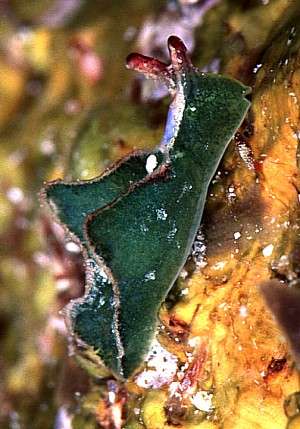
Elysia sp. 3.
Order: NUDIBRANCHIA
Superfamily: ELYSIOIDEA
Family: Elysiidae
PHOTO
Kerama Island, near Okinawa, Japan. 5m depth, 7mm length, in Jan.- May 1999. PHOTO: Atsushi Ono.
See message below
See two other species with similar large bimodal parapodial lobes: Elysia sp. 9 and Elysia sp. 10.
Authorship detailsRudman, W.B., 1999 (June 27) Elysia sp. 3. [In] Sea Slug Forum. Australian Museum, Sydney. Available from http://www.seaslugforum.net/find/elyssp3
Related messages
Re: another Elysia
June 30, 1999
From: Clay Carlson
re: another Elysia. This body morph is similar to some of the juvenile forms of a couple of species we have that feed on Caulerpa. At first we had them as separate species and then found some a bit smaller and others that were starting to stretch out a bit. We don't have one with red on the rhinophores nor the blue on the neck. The white mid dorsal spot probably marks the pericardium. If it has a long tube running aft of the pericardium it would even be more like our Caulerpa feeders. We were tempted to equate one of our species with E. subornata (=E. cauze) but Kathe Jensen said they differ internally so they have just remained Elysia sp.
Clay
clay.carlson@kuentos.guam.net
Carlson, C. & Hoff, P.J., 1999 (Jun 30) Re: another Elysia. [Message in] Sea Slug Forum. Australian Museum, Sydney. Available from http://www.seaslugforum.net/find/991And another Elysia sp from Kerama Is.
June 27, 1999
From: Atsushi Ono

Dear Bill,
Could you help me with another opisthobranch from Kerama Island, near Okinawa.
I think this is Elysia sp. too. 5m depth, 7mm length, in Jan.-May 1999. I observed 3 individuals.
They all have white spot on their back.
Their rhinophores color are green to red. Their size are 3 to 7mm.
Sincerely,
Atsushi Ono
ononini@cosmos.ne.jp
Ono, A., 1999 (Jun 27) And another Elysia sp from Kerama Is.. [Message in] Sea Slug Forum. Australian Museum, Sydney. Available from http://www.seaslugforum.net/find/973Dear Atsushi,
Another elysiid! The whitish blue spot behind the rhinophores looks as though it could be an important distinguishing feature of the colour pattern. However I can't find a described species with that pattern. In shape it looks somewhat like Crosslandia but the head and rhinophores don't look right.
Best wishes,
Bill Rudman.
